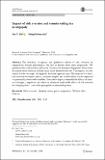Impact of risk aversion and countervailing tax in oligopoly
Date
12/2016Metadata
Show full item recordAbstract
The literature recognizes the qualitative effects of risk aversion on oligopolistic market performance, but less is known about their magnitudes. We quantitatively evaluate these effects in Cournot and Bertrand oligopolies where firms maximize mean-variance utilities under linear demand and costs. The impacts are very similar for the two types of oligopoly, but have opposite signs. The impacts of a firm’s risk aversion on outputs, prices, consumer surplus and social welfare can be expressed via potentially observable variables. Since these impacts resemble the effects of firms’ cost changes, a regulator can reduce or eliminate undesirable effects of risk aversion by changing firms’ costs with appropriate countervailing taxes.
Citation
Jin , J Y & Kobayashi , S 2016 , ' Impact of risk aversion and countervailing tax in oligopoly ' , Annals of Finance , vol. 12 , no. 3 , pp. 393-408 . https://doi.org/10.1007/s10436-016-0285-5
Publication
Annals of Finance
Status
Peer reviewed
ISSN
1614-2446Type
Journal article
Description
Kobayashi’s work was partially supported by JSPS KAKENHI Grant Number JP15K03462.Collections
Items in the St Andrews Research Repository are protected by copyright, with all rights reserved, unless otherwise indicated.

